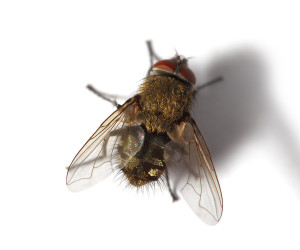Cluster Flies

Insect Control: How to Get Rid of Cluster Flies
Treatment includes a residual insecticide to window frames, door frames, cracks, crevices, soffit and fascia on the exterior & window frames, door frames, cracks, crevices, baseboards and attics on the interior. Treatments are generally done mid-August through mid-October in fall, and March-April in spring. Treatment may spot or streak windows, so it is recommended that window cleaning be done after treatment and only the window, not the frame.
How to Identify a Cluster Fly Infestation
- Adults measure 8 to 10 millimetres in length and have light and dark grey-checkered abdomens
- At first glance, they may look like house flies, but they are larger, darker and slower-moving
- The name “cluster fly” is used because of their habit of gathering in clusters after entering a house in the fall
- A fly problem becomes more obvious on days when temperatures rise and the flies become more active, gathering in windows where light attracts them
How to Prevent a Cluster Fly Infestation
- Make sure that all screens fit properly and that there are no cracks or holes that would allow flies to enter your house
- Weatherstrip windows and doors
- Fill any cracks or crevices with caulking around doors, window frames, and other openings in the building structure
Possible Health Concerns
Cluster flies are not usually a health hazard. However, they are a nuisance and are parasites on our earthworms.
About Cluster Flies
- Cluster flies emerge from the ground in early fall and spring. The females lay their eggs in soil and the larvae parasitize themselves on earthworms for about 15-20 days. The larvae then move near the surface and emerge as an adult a few days later
- They can enter a structure through any tiny openings and are simply trying to get over winter
- They are long-lived and on days where it might be particularly warm and sunny inside, they emerge, often in windows as the light attracts them

